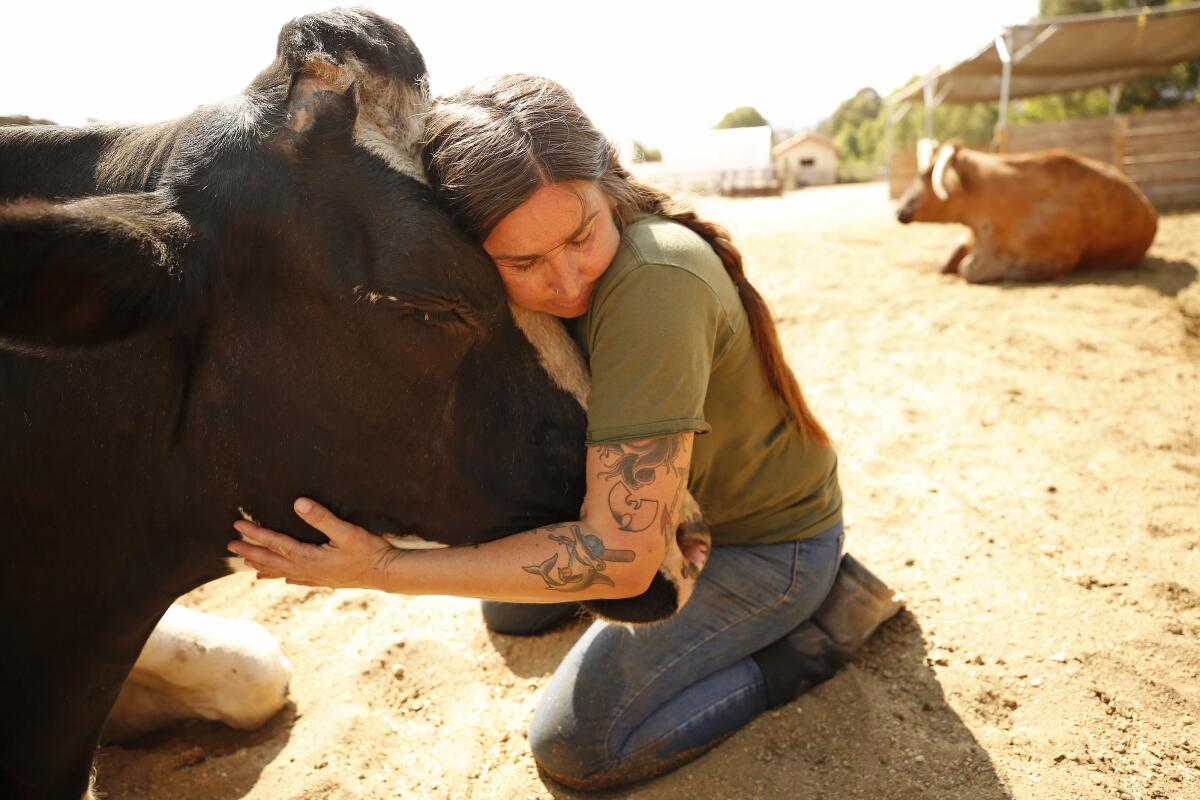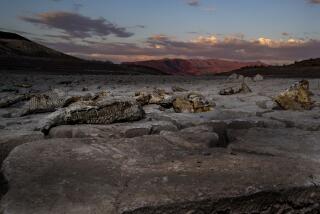Column: Apocalypse, cow — our growing drought and the great L.A. cattle escape

- Share via
The great cow escape happened on a late June evening. Forty cattle made a break for it through the streets of Pico Rivera in a sprint for their lives.
The fugitives were property of Manning Beef, the last meatpacker of its kind in L.A. The company had placed them in a holding pen before slaughter time, a daily task done with little fuss by workers for over 70 years. But this herd pushed open a gate.
What ensued wasn’t exactly a chase out of “Fast & Furious” or, more appropriately given the stakes (or is it steaks?), “To Live and Die in L.A.”
But it had a drama akin to a proper Los Angeles police chase, filmed by TV helicopters for a rapt audience where vegans and meat lovers alike were almost certainly united in rooting for the pursued.
The swift-hoofed black and brown Angus cattle trampled through residential streets. They knocked down people who tried to corral them before finally congregating on a cul de sac on Friendship Avenue awash in the flashing lights of police cars and helicopter floodlights.
When the escapees were finally rounded up, people called Pico Rivera City Hall and Manning Beef, begging for clemency — to no avail. The company butchered the animals, with a Manning Beef executive saying bluntly: “The animals were harvested. Note they were raised for public to consume.”
And that would have been that, except it turned out two cows were still on the lam.
And so here is where the big ol’ nerd in me takes a brief detour from the cattle’s fate to transport you to mid-19th century L.A. to explain what cows tell us about a monster that’ll be chasing after all of us soon.
The drought.
Once upon a time, about 160 years ago, Southern California was a collection of cattle empires, a holdover from Spanish and Mexican ranches. Long-horned steers roamed from Santa Barbara to what’s now Camp Pendleton, branded with the symbols of men whose last names remain on our streets and cities and schools: Yorba. Sepulveda. Pico. Temple. Verdugo.
We’re so far removed from those times that it’s almost like the sight of an honest-to-goodness stampede through suburbia tapped into Southern California’s collective unconscious and brought back warm memories few of us knew we had.
But there’s a reason why Southern California’s cattle era is rarely remembered, let alone discussed. It ended like a real-life biblical apocalypse, complete with floods, pestilence, locusts, and the worst drought in modern California history.
In 1860, the U.S. Census counted over 1.2 million cattle in California, with 70,000 in Los Angeles County alone. Local society was dependent on the industry — meat and hides for commerce, beef for food, rodeos for leisure. Although Californio families in the northern part of the state lost their lands to squatting 49ers and lawsuits in the wake of the Mexican-American War, those in Southern California carried on as if the Yankees never won.
Then came the deluge.
Historic rainfall across California in early 1862 turned the Central Valley into an inland sea and Los Angeles County into a mud pit. Thousands of cattle perished, but the subsequent growth of spring grass convinced the Californios to double down on their pastoral way of life. Rivers and streams flowed, and all was right again for a spell.
But no further rain fell that season. Or in the summer. Or the fall.
Once-fat cows began to look “like skeletons, and seem[ed] unable to move far from the springs and water courses,” according to the Los Angeles Star. They tried to eat anything with any hint of moisture, such as grapevines and bags that once contained rice, even.
The bad times were just beginning.
Grasshoppers showed up to devour what few crops emerged from the soil; smallpox killed so many people, particularly Native Americans and working-class Mexicans, that church bells ceased to toll. The drought got so bad that when it began to drizzle in early February 1864, the Star celebrated the news with the headline, “Rain! Rain!! Rain!!!” Its rival, the Semi-Weekly Southern News, proclaimed: “At last through hopes and fears, and smiles and tears, we have an evidence, in the shape of a heaven-sent and glorious rain, that God has not forgotten us.”
But a heat wave and Santa Ana winds quickly dried out all that moisture, and “the earth once more became iron and the sky brass,” historian Robert Glass Cleland wrote decades later.
“The drought of the past year has caused extraordinary hardship to the country,” L.A. Mayor Damien Marchessault said in his 1864 State of the City speech. Native Americans who lived near the Colorado River said it was at the lowest level they could ever recall. Livestock began to die en masse. Some ranchers drove their herds off the cliffs of San Pedro for a quicker death.
A traveler described the trail back to Los Angeles as “a regular mass of dead cattle.”
The drought finally ended in early 1865. Although there are no official weather records from those years, an 1890 article in the Historical Society of Southern California claimed the rainfall for the 1862-63 season “did not exceed four inches” and the following year “was even less.”
By comparison, the most recent rain year in Los Angeles ended last month with 5.82 inches of precipitation.
The calamity changed Southern California forever. About 70% of Southern California’s cattle died, and so many of their skulls dotted the landscape for years afterward that an observer described it as a “veritable Golgotha.”
Nearly all the local Californio ranchers lost their lands through bankruptcy, fire sales, or to sons-in-laws who married Mexican women mostly for their inheritance. But instead of learning the lesson of the Great Drought — live within your means in a region more often dry than not — Southern California’s new ruling class created yet another world that lived against its environment, not with it.
We now seem to be at the tail end of that epoch, as water dwindles across the West and, like the Californios of yore, we have no ready answer for what’s next.
Which brings me back to the two escaped cows that were spared the slaughterhouse.
One was found roaming around Whittier Narrows Park in South El Monte two days after its escape. The second was found a week later trotting along the 60 Freeway on its way to La Puente. Grammy-winning songwriter Diane Warren and others donated money and time so that the two were spared a trip to the abattoir and instead went to animal advocacy group Farm Sanctuary, which runs a 40-acre rescue ranch in Acton, on the edge of the Antelope Valley.
Jess Due, the nonprofit’s national care director, told me the public was already clamoring to meet the pair, now named June B. Free and Susan. They’re currently in quarantine, a standard procedure for any new animals to ensure they’re disease-free, then will join Farm Sanctuary’s 140 other rescued animals — among them, nine rescued steers and cows — for visitors to coo at and photograph.
I was able to score a private audience with June B. Free and Susan last week.
To get there, I zipped up the 14 Freeway to Farm Sanctuary on a Friday morning. Hills with vegetation the color of manila envelopes gave way to new tract housing advertised with a large sign that screamed, “Reimagining the Suburban Experience.”
Due greeted me when I arrived. The 39-year-old knew about the 1863 drought, and scoffed at the idea that driving cattle off cliffs was a “humane” way to end their lives.
“As a species, if we do not stop ignoring what Mother Earth is telling us about our practices, she’s gonna do it for us. And it’s not going to be humans winning,” Due said as we walked past a chicken and turkey coop. All of Farm Sanctuary’s trucks had trailers hitched on, in case a fire — just another thing that drought increases the chances of — forced an evacuation.
After a short hike, we finally reached June B. Free and Susan. The two lounged in the morning sun in a private dirt pen ringed by juniper trees. A massive tub filled with water was near the gate, along with bins of specialized feed to fatten them up.
It was a picturesque scene until I looked closer.
Their ribs were visible, along with scars from the zaps of electric cattle prods. Each had ripped ears and burns on their backside. Susan has an injury to her hind leg; June B. Free doesn’t allow people closer than 10 feet to her before she tries to charge them. Both of their udders were swollen, a sign that the two had recently given birth.
June B. Free immediately rose when she saw Due and I. She assumed a defensive position and stood in front of Susan.
“They went through a horror movie,” Due said, before yelling at them, “I love you! You’re kinda badasses, you know?”
They were. They were alive. They had cheated certain doom by figuring out how to flee their fate.
Now, let’s see if we can put our allegedly big Homo sapien brains to use to wrangle the stampede of inexorable drought.
More to Read
Sign up for Essential California
The most important California stories and recommendations in your inbox every morning.
You may occasionally receive promotional content from the Los Angeles Times.












